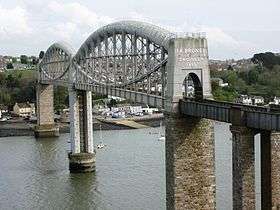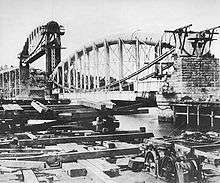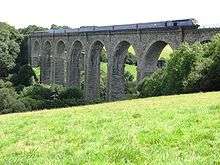Cornish Main Line
The Cornish Main Line (Cornish: Penn-hyns-horn Kernow) is a railway line in Cornwall in the United Kingdom. It runs from Penzance to Plymouth, crossing from Cornwall into Devon over the famous Royal Albert Bridge at Saltash.
| Cornish Main Line | |
|---|---|
 | |
| Overview | |
| Type | Heavy rail |
| System | National Rail |
| Status | Operational |
| Locale | Cornwall, United Kingdom |
| Termini | Plymouth Penzance |
| Operation | |
| Opened | 1867 |
| Owner | Network Rail |
| Operator(s) | Great Western Railway CrossCountry (Freight: DB Schenker and Freightliner) |
| Technical | |
| Line length | 79.5 miles (128 km) |
| Number of tracks | Double with two single track sections |
| Track gauge | 4 ft 8 1⁄2 in (1,435 mm) standard gauge |
| Operating speed | 75 mph (121 km/h) maximum[1] |
It directly serves Truro, St Austell, Bodmin (by a Parkway station), and Liskeard. It forms the backbone for rail services in Cornwall and there are branches off it which serve St Ives, Falmouth, Newquay, and Looe. The main line also carries direct trains to and from London, Birmingham, the north of England and Scotland.
It is the southernmost railway line in the United Kingdom, and the westernmost in England.
History

The Cornish Main Line was originally built by two separate railway companies, the West Cornwall Railway between Truro and Penzance, opened in 1852, and the Cornwall Railway between Plymouth and a separate station in Truro, opened in 1859. The West Cornwall Railway was itself based on the Hayle Railway, opened in 1837 as a purely local mineral railway.
Rail travel from Penzance to London was possible from 1860 when the West Cornwall company was given access to the Cornwall Railway’s Truro station, but the West Cornwall trains were standard gauge and the Cornwall Railway was broad gauge, so through passengers had to change trains there and goods had to be transhipped into wagons of the other gauge at Truro.
The impecunious West Cornwall company sold its railway to the more powerful broad gauge Associated Companies, dominated by the Great Western Railway, and the new owners converted the West Cornwall line to broad gauge. Through goods trains started running in 1866 and passenger trains in 1867.
The Associated Companies merged into the Great Western Railway, and in 1892 the Great Western converted all its broad gauge track to standard gauge, a process called the gauge conversion.
Both the West Cornwall and the Cornwall railways had been built cheaply and had numerous timber trestle viaducts; these were cheap to build but very expensive to maintain, as the timber decayed, and the iconic viaducts were eventually all reconstructed in masonry or masonry and wrought iron, or in a few cases by-passed. Those on the Cornwall Railway section are described at Cornwall Railway viaducts.
The most iconic structure on the route, however, is the Royal Albert Bridge spanning the River Tamar and opened in 1859; it remains in use to the present day.
During the later decades of the nineteenth century and the first half of the twentieth, the Great Western Railway was famous for providing transport to holiday destinations in Cornwall, and there were numerous branch lines served from the Cornish main line giving access to the resorts. The physical limitations of the steeply graded line imposed severe problems during the busiest times, not least for goods train operation. Equally famous was the line’s use for transporting vegetable produce from Cornwall, famously broccoli and cauliflower, and cut flowers from the Isles of Scilly.
To cope with the increasing traffic the line was gradually doubled between 1893 and 1930.[2]
Many of the branch lines were closed during the second half of the twentieth century, but in Cornwall the Looe, Newquay, Falmouth and St Ives branches remain in operation, with a basic local passenger traffic in winter considerably boosted by holidaymakers in summer. The historical development of the line is more fully dealt with at Hayle Railway, West Cornwall Railway, and Cornwall Railway. [3]
Accidents
The Cornwall Main Line has been a very safe railway for passengers, with only a few accidents in the 19th century. These include:
- Grove Viaduct, St Germans – derailment, 6 May 1859.
- St Austell – runaway train, 29 October 1872.
- Menheniot – collision, 2 December 1873.
- Bodmin Road – derailment, 13 April 1895.
Route
Cornish Main Line | ||||||||||||||||||||||||||||||||||||||||||||||||||||||||||||||||||||||||||||||||||||||||||||||||||||||||||||||||||||||||||||||||||||||||||||||||||||||||||||||||||||||||||||||||||||||||||||||||||||||||||||||||||||||||||||||||||||||||||||||||||||||||||||||||||||||||||||||||||||||||||||||||||||||||||||||||||||||||||||||||||||||||||||||||||||||||||||||||||||||||||||||||||||||||||||||||||||||||||||||||||||||||||||||||||||||||||||||||||||||||||||||||||||||||||||||||||||||||||||||||||||||||||||||||||||||||||||||||||||||||||||||||||||||||||||||||||||||||||||||||||||||||||||||||||||||||||||||||||||||||||||||||||||||||||||||||||||||||||||||||||||||||||||||||||||||||||||||||||||||||||||||||||||||||||||||||||||||||||||||||||||||||||||||||||||||||||||||||||||||||||||||||||||||||||||||||||||||||||||||||||||||||||||||||||||||||||||||||||||||||||||||||||||||||||||||||||||||||||||||||||||||||||||||||||||||||||||||||||||||||||||||
|---|---|---|---|---|---|---|---|---|---|---|---|---|---|---|---|---|---|---|---|---|---|---|---|---|---|---|---|---|---|---|---|---|---|---|---|---|---|---|---|---|---|---|---|---|---|---|---|---|---|---|---|---|---|---|---|---|---|---|---|---|---|---|---|---|---|---|---|---|---|---|---|---|---|---|---|---|---|---|---|---|---|---|---|---|---|---|---|---|---|---|---|---|---|---|---|---|---|---|---|---|---|---|---|---|---|---|---|---|---|---|---|---|---|---|---|---|---|---|---|---|---|---|---|---|---|---|---|---|---|---|---|---|---|---|---|---|---|---|---|---|---|---|---|---|---|---|---|---|---|---|---|---|---|---|---|---|---|---|---|---|---|---|---|---|---|---|---|---|---|---|---|---|---|---|---|---|---|---|---|---|---|---|---|---|---|---|---|---|---|---|---|---|---|---|---|---|---|---|---|---|---|---|---|---|---|---|---|---|---|---|---|---|---|---|---|---|---|---|---|---|---|---|---|---|---|---|---|---|---|---|---|---|---|---|---|---|---|---|---|---|---|---|---|---|---|---|---|---|---|---|---|---|---|---|---|---|---|---|---|---|---|---|---|---|---|---|---|---|---|---|---|---|---|---|---|---|---|---|---|---|---|---|---|---|---|---|---|---|---|---|---|---|---|---|---|---|---|---|---|---|---|---|---|---|---|---|---|---|---|---|---|---|---|---|---|---|---|---|---|---|---|---|---|---|---|---|---|---|---|---|---|---|---|---|---|---|---|---|---|---|---|---|---|---|---|---|---|---|---|---|---|---|---|---|---|---|---|---|---|---|---|---|---|---|---|---|---|---|---|---|---|---|---|---|---|---|---|---|---|---|---|---|---|---|---|---|---|---|---|---|---|---|---|---|---|---|---|---|---|---|---|---|---|---|---|---|---|---|---|---|---|---|---|---|---|---|---|---|---|---|---|---|---|---|---|---|---|---|---|---|---|---|---|---|---|---|---|---|---|---|---|---|---|---|---|---|---|---|---|---|---|---|---|---|---|---|---|---|---|---|---|---|---|---|---|---|---|---|---|---|---|---|---|---|---|---|---|---|---|---|---|---|---|---|---|---|---|---|---|---|---|---|---|---|---|---|---|---|---|---|---|---|---|---|---|---|---|---|---|---|---|---|---|---|---|---|---|---|---|---|---|---|---|---|---|---|---|---|---|---|---|---|---|---|---|---|---|---|---|---|---|---|---|---|---|---|---|---|---|---|---|---|---|---|---|---|---|---|---|---|---|---|---|---|---|---|---|---|---|---|---|---|---|---|---|---|---|---|---|---|---|---|---|---|---|---|---|---|---|---|---|---|---|---|---|---|---|---|---|---|---|---|---|---|---|---|---|---|---|---|---|---|---|---|---|---|---|---|---|---|---|---|---|---|---|---|---|---|---|---|---|---|---|---|---|---|---|---|---|---|---|---|---|---|---|---|---|---|---|---|---|---|---|---|---|---|---|---|---|---|---|---|---|---|---|---|---|---|---|---|---|---|---|---|---|---|---|---|---|---|---|---|---|---|---|---|---|---|---|---|---|---|---|---|---|---|---|---|---|---|---|---|---|---|---|---|---|---|---|---|---|---|---|---|---|---|---|---|---|---|---|---|---|---|---|---|---|---|---|---|---|---|---|---|---|---|---|---|---|---|---|---|---|---|---|---|---|---|---|---|---|---|---|---|---|---|---|---|---|---|---|---|---|---|---|---|---|---|---|---|---|---|---|---|---|---|---|---|---|---|---|---|---|---|---|---|---|---|---|---|---|---|---|---|---|---|---|---|---|---|---|---|---|---|---|---|---|---|---|---|---|---|---|---|---|---|---|---|---|---|---|---|---|---|---|---|---|---|---|---|---|---|---|---|---|---|---|---|---|---|---|---|---|---|---|---|---|---|---|---|---|---|---|---|---|---|---|---|---|---|---|---|---|---|---|---|---|---|---|---|---|---|---|---|---|---|---|---|---|---|---|---|---|---|---|---|---|---|---|---|---|---|---|---|---|---|---|---|---|---|---|---|---|---|---|---|---|---|---|---|---|---|---|---|---|---|---|---|---|---|---|---|---|---|---|---|
| ||||||||||||||||||||||||||||||||||||||||||||||||||||||||||||||||||||||||||||||||||||||||||||||||||||||||||||||||||||||||||||||||||||||||||||||||||||||||||||||||||||||||||||||||||||||||||||||||||||||||||||||||||||||||||||||||||||||||||||||||||||||||||||||||||||||||||||||||||||||||||||||||||||||||||||||||||||||||||||||||||||||||||||||||||||||||||||||||||||||||||||||||||||||||||||||||||||||||||||||||||||||||||||||||||||||||||||||||||||||||||||||||||||||||||||||||||||||||||||||||||||||||||||||||||||||||||||||||||||||||||||||||||||||||||||||||||||||||||||||||||||||||||||||||||||||||||||||||||||||||||||||||||||||||||||||||||||||||||||||||||||||||||||||||||||||||||||||||||||||||||||||||||||||||||||||||||||||||||||||||||||||||||||||||||||||||||||||||||||||||||||||||||||||||||||||||||||||||||||||||||||||||||||||||||||||||||||||||||||||||||||||||||||||||||||||||||||||||||||||||||||||||||||||||||||||||||||||||||||||||||||||

The communities served are: Plymouth (including the suburbs of Devonport and St Budeaux); Saltash; St Germans; Menheniot; Liskeard; Bodmin; Lostwithiel; Par; St Austell; Truro; Redruth; Camborne; Hayle; St Erth; Penzance. In addition branch lines link Plymouth with Bere Alston, Calstock, and Gunnislake; Liskeard with Looe; Par with Newquay; Truro with Penryn and Falmouth; and St Erth with St Ives.
The railway stations at St Austell and Penzance are adjacent to bus stations. In addition, integrated bus services operate from Bodmin Parkway to Bodmin, Wadebridge, and Padstow; from St Austell to The Eden Project; and from Redruth to Helston and RNAS Culdrose.
The route has a large number of viaducts, but the most significant structure is the Royal Albert Bridge[4] which crosses the River Tamar at Saltash. At Truro the viaducts give sweeping views of the city and River Fal, while further west the north coast can be seen near Hayle before the line swings onto the south coast for the last mile or so along the beach at Marazion, giving a good view of St Michael's Mount.
Nominal line speed is 65 mph (105 km/h) but there are local restrictions at many places. The route is mostly double-tracked and cleared for trains up to W7 and W6A gauges.[5] The 7.5-mile (12.1 km) section of single track from Burngullow to Probus (between the stations at St Austell and Truro) used to be a major cause of delays in the region, requiring trains to wait for preceding trains to clear the singled section before proceeding. The second track was restored in August 2004. The total cost of the project was £14.3 million and was funded by Objective One, Strategic Rail Authority and Cornwall County Council.
Usage
The number of passengers travelling on the Cornish Main Line has increased in the last few years. Between 2004/05 and 2011/12, with the exception of Keyham and Menheniot, all stations have reported an increase of at least 33% while Hayle, Par, Saltash and St Budeaux Ferry road all reported calculated to be in excess of 200%. The busiest stations are Plymouth, Penzance and Truro which all handle more than one million people arriving or departing each year. St Austell, Redruth and Liskeard all had more than 300,000 people in 2011-12, increases of around 50% or 60% over 2004/05.[6]
| Station usage | ||||||||||||||||
|---|---|---|---|---|---|---|---|---|---|---|---|---|---|---|---|---|
| Station name | 2002–03 | 2004–05 | 2005–06 | 2006–07 | 2007–08 | 2008–09 | 2009–10 | 2010–11 | 2011–12 | 2012–13 | 2013–14 | 2014–15 | 2015–16 | 2016–17 | 2017–18 | 2018–19 |
| Plymouth | 1,431,674 | 1,519,011 | 1,629,011 | 1,845,958 | 2,026,851 | 2,249,849 | 2,278,718 | 2,401,082 | 2,487,562 | 2,509,452 | ||||||
| Dockyard | 4,070 | 5,088 | 4,895 | 5,335 | 4,924 | 5,274 | 5,524 | 5,406 | 4,160 | 4,728 | ||||||
| Keyham | 8,957 | 6,374 | 7,594 | 7,976 | 5,055 | 5,600 | 5,016 | 6,330 | 7,338 | 9,122 | ||||||
| St Budeaux Ferry Road | 987 | 969 | 1,015 | 1,037 | 1,199 | 1,132 | 1,540 | 2,326 | 2,980 | 3,976 | ||||||
| Saltash | 27,197 | 35,349 | 32,186 | 34,266 | 32,062 | 47,244 | 49,578 | 59,240 | 67,174 | 78,198 | ||||||
| St Germans | 25,681 | 24,926 | 28,228 | 29,540 | 29,073 | 37,718 | 38,258 | 44,758 | 58,676 | 60,320 | ||||||
| Menheniot | 6,554 | 5,782 | 4,453 | 4,206 | 3,610 | 4,598 | 3,844 | 2,690 | 5,096 | 5,858 | ||||||
| Liskeard | 209,875 | 232,269 | 237,113 | 267,864 | 274,090 | 294,638 | 289,276 | 309,162 | 351,394 | 358,324 | ||||||
| Bodmin Parkway | 144,146 | 158,172 | 166,743 | 185,498 | 203,061 | 225,140 | 221,616 | 235,876 | 234,792 | 236,190 | ||||||
| Lostwithiel | 40,701 | 42,602 | 46,172 | 46,645 | 51,695 | 61,716 | 68,336 | 73,584 | 67,472 | 72,530 | ||||||
| Par | 78,175 | 95,475 | 111,912 | 119,859 | 139,688 | 160,832 | 162,872 | 179,100 | 190,168 | 195,732 | ||||||
| St Austell | 266,676 | 275,056 | 281,545 | 314,613 | 360,484 | 388,878 | 395,222 | 436,440 | 464,000 | 472,538 | ||||||
| Truro | 638,727 | 714,954 | 772,674 | 856,474 | 917,184 | 997,368 | 1,042,412 | 1,161,138 | 1,201,010 | 1,202,942 | ||||||
| Redruth | 186,977 | 219,013 | 228,511 | 258,384 | 277,853 | 292,940 | 284,462 | 308,444 | 334,194 | 340,356 | ||||||
| Camborne | 109,628 | 146,595 | 157,026 | 181,671 | 193,948 | 215,600 | 224,950 | 247,360 | 269,034 | 262,070 | ||||||
| Hayle | 34,802 | 43,467 | 51,299 | 63,593 | 60,174 | 73,868 | 77,172 | 85,508 | 81,732 | 79,198 | ||||||
| St Erth | 71,406 | 90,541 | 88,341 | 67,004 | 68,230 | 75,026 | 75,248 | 120,770 | 257,802 | 251,858 | ||||||
| Penzance | 392,008 | 403,000 | 413,905 | 461,764 | 498,290 | 526,132 | 520,982 | 556,546 | 543,036 | 560,338 | ||||||
| The annual passenger usage is based on sales of tickets in stated financial years from Office of Rail Regulation statistics. The statistics are for passengers arriving and departing from each station and cover twelve month periods that start in April. Methodology may vary year on year. Barking and Blackhorse Road are affected by usage of the ticket gates for the underground and that Gospel Oak connects to the North London Line section of the London Overground and is similarly affected. Barking is further affected by the ticket gates used to access C2C services. | ||||||||||||||||
See also
- Cornwall Railway
- Cornwall Railway viaducts
- Disused railway stations (Plymouth to Penzance Line)
- Great Western Main Line
- West Cornwall Railway
References
Notes
- "Archived copy" (PDF). Archived from the original (PDF) on 14 October 2013. Retrieved 16 August 2014.CS1 maint: archived copy as title (link)
- Railway Magazine October 1963 p. 747
- MacDermot, E.T. (1931). History of the Great Western Railway. Volume II 1863-1921. London: Great Western Railway.
- Binding, John (1997). Brunel's Royal Albert Bridge. Truro: Twelveheads Press. ISBN 0-906294-39-8.
- Route 12: Reading to Penzance (PDF). Network Rail. 2007. p. 17. Archived from the original (PDF) on 25 September 2012. Retrieved 10 April 2013.
- "Station Usage". Rail Statistics. Office of Rail Regulation.
Sources and further reading
- Bennett, Alan (1990). The Great Western Railway in East Cornwall. Cheltenham: Runpast Publishing. ISBN 1-870754-11-5.CS1 maint: ref=harv (link)
- Bennett, Alan (1988). The Great Western Railway in Mid Cornwall. Southampton: Kingfisher Railway Publications. ISBN 0-946184-53-4.CS1 maint: ref=harv (link)
- Bennett, Alan (1988). The Great Western Railway in West Cornwall. Cheltenham: Runpast Publishing. ISBN 1-870754-12-3.CS1 maint: ref=harv (link)
- Binding, John (1993). Brunel's Cornish Viaducts. Penryn: Atlantic Transport Publishing for Historical Model Railway Society. ISBN 0-906899-56-7.CS1 maint: ref=harv (link)
- Central Publicity Unit (Winter 1979). Railway Electrification. British Railways Board. pp. 0–2, 8.CS1 maint: ref=harv (link)
- Hesp, Martin (7 July 2008). "My magnificent rail journey". Western Morning News. Archived from the original on 25 November 2010. Retrieved 14 July 2008.CS1 maint: ref=harv (link)
